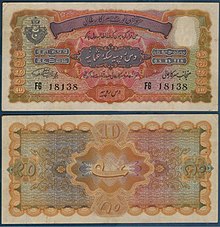
Back منطقة الجنيه الاسترليني Arabic Zona esterlina AST Zona esterlina Catalan Zona esterlina Spanish Zone sterling French גוש השטרלינג HE Area della sterlina Italian 스털링 지역 Korean စတာလင်နယ် Burmese Blok szterlingowy Polish
This article needs additional citations for verification. (September 2023) |

The sterling area (or sterling bloc, legally scheduled territories)[1][2] was a group of countries that either pegged their currencies to sterling, or actually used sterling as their own currency.
The area began to appear informally during the early 1930s, after sterling had left the gold standard in 1931, with the result that a number of currencies of countries that historically had performed a large amount of their trade in sterling were pegged to sterling instead of to gold. A large number of these countries were part of the British Empire; however, a significant minority were not.
Early in the Second World War, emergency legislation united the sterling bloc countries and territories (except Hong Kong) of the British Empire in a single exchange control area to protect the external value of sterling, among other aims. Canada and Newfoundland were already linked to the US dollar and did not join the sterling bloc.[3]
The Bank of England in London guided co-ordination of monetary policy in the currency area. Member countries with their own currency held a large portion of their foreign currency reserves as sterling balances in London.
After the Second World War, the Bretton Woods system of fixed exchange rates to the US dollar (convertible to gold) gave the sterling area a second lease of life as Commonwealth of Nations kinship and trading loyalties were maintained after Britain's withdrawal from Empire by keeping a sterling peg and staying in the sterling area, rather than maintaining a direct dollar peg. Despite this, sterling did not regain anything like its place in international commerce that it had had before the war, and a devastated and financially exhausted Britain could not defend the international value of sterling to maintain confidence in the system, resulting in its devaluation of the pound sterling against the dollar in 1967 that was not reflected in other sterling area currencies. In the end the US dollar's inability to hold to the Bretton Woods gold standard precipitated the end of the era of fixed exchange rates: with all major currencies including the pound floating against the US dollar, the sterling area had lost its final raison d'être.
In June 1972, the British government unilaterally applied exchange controls to the other sterling area countries, with the exception of Ireland, the Isle of Man and the Channel Islands. This arguably marked the end of the sterling area. During the rest of the 1970s and early 1980s, the remaining sterling balances were wound down to a level that represented the significance of Britain in contemporary world trade.
- ^ Haraszti, György (1981). Questions of International Law. Vol. 2. Brill. p. 114. ISBN 90-286-0830-3.
it was not until 1947, under the aegis of the British Exchange Control Act, that the area acquired some degree of legal formality. In that Act the members of the sterling area are referred to as the "scheduled territories" [...]
- ^ Schenk, Catherine (2010). The Decline of Sterling. Cambridge Univ. Press. p. 22. ISBN 978-1-139-48725-2.
The [Exchange Control Act] identified members of the sterling area as 'scheduled territories'.
- ^ "Sterling Area (Hansard, 18 July 1972)". api.parliament.uk.